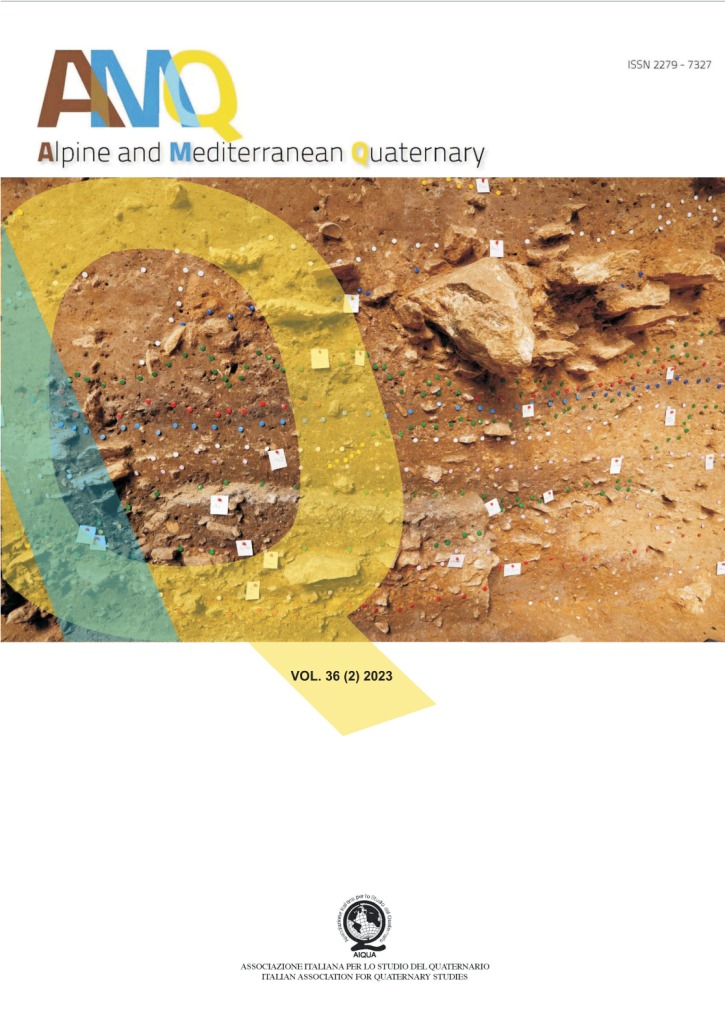Adaptations and cultures of Pleistocene humans in Italy
Main Article Content
Abstract
Continental and above all peninsular Italy, preserve abundant biological and cultural fossil record, sometimes geographically and ecologically so peculiar contexts, to stimulate the study of population dynamics, adaptations, cultural transitions that took place during the whole Pleistocene in this country. In such a variegated region, bounded by the Alpine chain and longitudinally split by the Apennines, Italy hosted distinct migration waves attributed to unidentified hominins, and to Homo heidelbergensis, Homo neanderthalensis, Homo sapiens in a heterogeneous scenario subjected to profound changes during extreme sea-level lowering. The first human colonization occurred around the Early to Middle Pleistocene transition, presumably driven by major faunal renewals which invested Southern Europe. These first attestations are documented in the oldest sites, Pirro Nord and Monte Poggiolo, with lithic industries based on core-and-flake technology. After a gap in the evidence of human settlements between MIS19 and MIS17, the earliest Acheulean makes its appearance in south Italy starting from 661-614 ka. Large cutting tools typical of this complex remain however poorly represented throughout the early Middle Pleistocene, in favour of the tiny and medium-sized flakes which feature the lithic industries until the conventional end of Lower Palaeolithic. Specifically, these small tools mark the Middle Pleistocene interaction between hominins and elephants, as attested at many sites in central Italy. As regards the Middle Palaeolithic, its archaeological and anthropological record looks more consistent and proves that Neanderthals inhabited southern Europe and Italy, leaving Sicily still lacking undisputable evidence. The Neanderthal record refers to settlement patterns and mobility strategies in the geographic and environmental districts that feature most of the regions at the alpine fringe, along the Apennine chain and the rocky coasts. Settlements have complementarity character, with long-term occupations and other locations used for short time, particularly caves and sheltered sites, where the stratigraphic sequences record multi-occupations covering large time intervals and repeated environmental changes. As a matter of fact, some environmental changes are related to cultural turnovers like the appearance of the Mousterian Quina during MIS4 in the North of Italy. Hunting and dietary behaviour reconstructed from a number of sites stimulates debate around possible convergencies or divergencies between Neanderthals and the first Homo sapiens communities that started settling Italy since about 44-43 ky cal BP. Pieces of the Neanderthal-sapiens biocultural transition with contested attributions have been unveiled in recent years at key archaeological sites, either in the North and in the South of Italy, producing an incontestable contribution for reconstructing these dynamics in Europe. This is specifically the case of the Uluzzian with its cultural package of lithic and bone technologies and ornamental beads, which follows in time the oldest known cultural expressions of Homo sapiens in other regions of Western Eurasia. The spread of early Sapiens is also related to the Aurignacian and marks another intriguing cultural dynamic of the Upper Paleolithic, prolongating across the Last Glacial Maximum and the Late Glacial, two turning points for the bio-geographic, anthropological and cultural evolution marked by the loss of large continental plains and the rearrangement of all ecozones of human populations. As consequence of the Late Glacial interstadial warming, a large-scale Epigravettian colonization of the mountain ranges started and continued in the Mesolithic until the disappearance of those hunter-gatherer populations.
Article Details
Issue
Section

This work is licensed under a Creative Commons Attribution-NonCommercial-NoDerivatives 4.0 International License.
The Author grants usage rights to others using an open license (Creative Commons or equivalent) allowing for immediate free access to the work and permitting any user to read, download, copy, distribute, print, search, or link to the full texts of articles, crawl them for indexing, pass them as data to software, or use them for any other lawful purpose.

